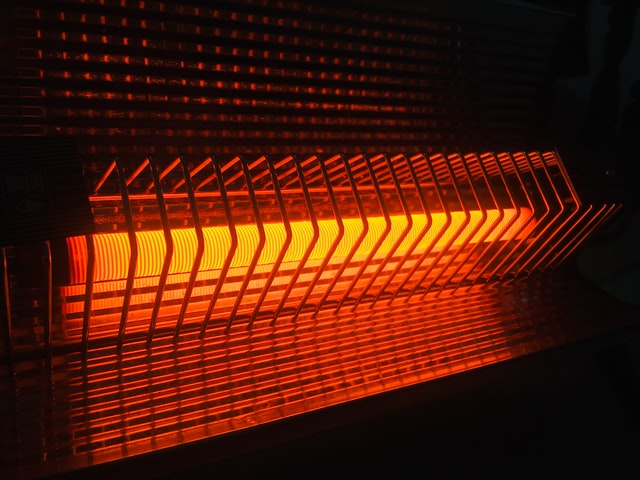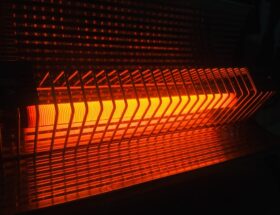Types of heater
How you use a room will help you to decide the type of heater that’s most suitable. For larger rooms you want to heat regularly, like a living room, it’s worth paying a bit more upfront for a fixed heater with lower running costs and more heat output than an electric heater.
要選擇用哪種方式取暖,取決於你如何使用你的室內空間。對於大空間來說像客廳,安裝一台heat pump,剛開始是一筆龐大的開銷,但以長遠計劃來說省下來的電費比你用電暖氣來的好。
This could be a modern wood or wood-pellet burner, an energy efficient heat pump, or a four-star flued gas heater. Electric heaters may be enough for smaller rooms and rooms you only heat occasionally, like bedrooms – they’re cheap to buy but more expensive to run.
使用電暖氣的場合像是,小空間、房間、車庫等使用頻率比較不高的地方,而且電暖氣的價格相對便宜很多。

Heat pumps
| 優點 | Be aware that: |
| low running costs (when you use them properly)producing instant heatconvenience – you can control the temperature with the thermostat and use the timer. | they must be sized correctly – for the space and the climate – to work well (if you live in a colder area, ask the supplier to size the heat pump based on its low temperature performance)some are a lot more efficient than others – look for the Energy Rating Label (the more stars, the more energy efficient)they won’t work during a power cut. |
優點
省電、用電的效率較高 (當你使用得宜的話),可以立即得到暖房效果,且又可以控制室溫、與定時功能。
但要注意購買的時選擇適當的size,例如家用與商業辦公室用的機型、大小等都不儘相同。
Modern woodburners
| Good for: | Be aware that: |
| low running costs, especially if you have access to free or cheap firewoodthe environment – if used correctly, they produce very little pollution and use renewable wood energyheating large spacesheating hot water in winter through a wetback system. | firewood must be dry to burn cleanly and efficiently, so you need to plan ahead and store it undercover, ideally for at least 12 monthsyou need a building consent to install one and – unless your property is larger than two hectares – you need to use a woodburner on the approved list from the Ministry for the Environment. |
Electric heaters
| Good for: | Be aware that: |
| heating smaller spaces, like bedroomsvery cheap to buy. | they are more expensive to run than most other heating optionstheir heat output is low compared to most other heater typesall electric heaters are equally efficient as they convert all the electricity they use into useful heatthere are different types (radiant, convection, fan) that deliver heat in different ways to suit different situationsmany have built-in thermostats, but generally they aren’t very accurate. |
Choose the right heating for you and your family
A warm home is vital for your comfort and health. The World Health Organisation’s recommended minimum indoor temperature is 18°C in living areas and 16°C in bedrooms. Recommendations for babies and elderly people are even higher.
In New Zealand heating is expensive (typically accounting for about 30 per cent of a household’s annual energy consumption). As energy prices rise and houses are getting bigger it is likely to cost even more.
Most people use electricity, gas or wood to heat their homes. Newer heating systems are more energy efficient and can reduce your power bills, while simple actions can make your existing heating options more efficient.
Types of heater on the EECA Energywise website has an overview of the pros and cons of different heating systems.
Choosing a heater on the Consumer NZ website is a comparison of the cost of different heaters and fuels (Note: You must subscribe to Consumer NZ to read it).
Remember, insulating your home reduces the amount of heating you need to keep your home at a comfortable temperature.
Radiant heaters
Types of residential radiant heaters include:
- electric radiant panel or element heaters (including infrared panel heaters), wall or ceiling-mounted
- bathroom ceiling-mounted electric heat lamps (with exhaust air duct)
- gas-fired infrared (outdoor) heaters
- gas-fired radiant tube heaters
- gas fires (visible flame) (a number of gas fires provide both radiant and convection heating)
- electric tubular heaters.
Characteristics of radiant heaters
- Someone directly in front of the heater will feel immediately warmer when it is turned on and immediately cooler when it is turned off.
- Only surfaces in a direct line of sight to the heater are heated.
- Though air isn’t directly warmed, it will warm up through contact with surfaces that have been heated.
- Heating intensity increases as the surface gets closer to the heater.
Uses of radiant heaters
Radiant heaters can be useful for heating spaces with:
- short-term room occupancy (for example, using a bathroom, making a drink in a kitchen)
- a need for immediate warmth
- large size (for example, long rooms, rooms with high ceilings) to directly provide heat to occupants
- high or fast air flow from outside or other cooler spaces (for example, garage, basement, deck)
- high transmission heat loss through walls or the floor or ceiling (for example, a conservatory in winter)
- high humidity (for example, bathrooms) with surfaces that temporarily need to be clear of condensation (for example, mirrors)
- occupants who are very active and mobile while in the room (for example, people doing aerobics or working in a garage workshop)
- rooms with thermal mass (as the heater warms the mass).
A radiant heater will be less effective and less efficient compared to a convection heater if:
- the radiant heat cannot freely radiate into the room (for example, because the heater is behind furniture) and/or directly on to the room occupant
- the heater is distant from the occupant
- it is installed directly facing a window – heat energy will be lost through the glass
- the room is already very warm and near to desired air temperature
- the room has longer-term problems with condensation and moisture damage
- tight thermostatic control is required
- safety from touch is an issue.







